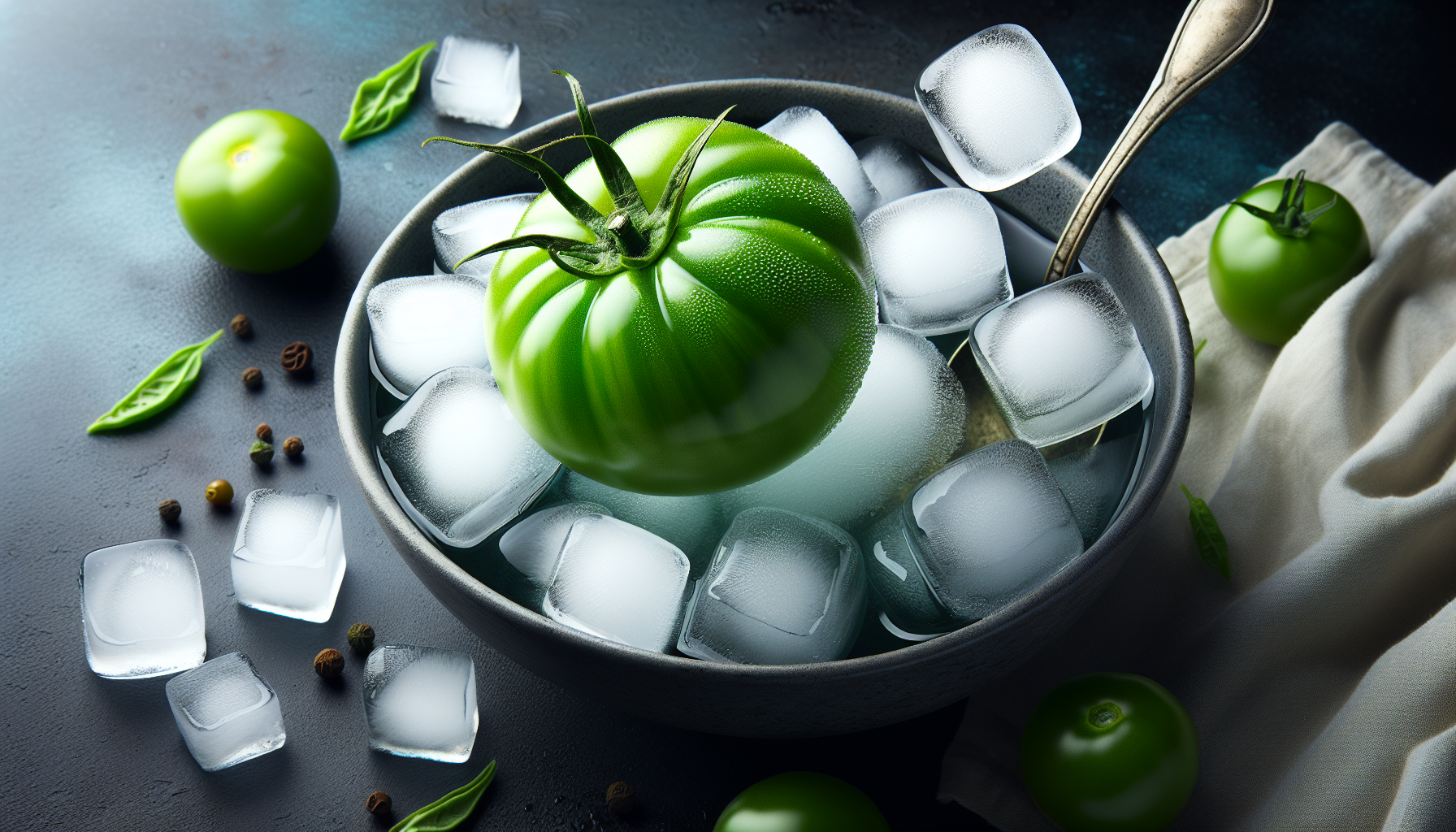Imagine you have a surplus of green tomatoes from your garden and don’t want them to go to waste. Well, we’ve got good news for you! In this article, we will share a simple and efficient way to freeze your green tomatoes, allowing you to enjoy their freshness and flavor even during the colder months. Whether you’re planning to use them for cooking, making salsa, or preserving their vibrant green color, our step-by-step guide will ensure you make the most of your harvest. So, let’s get started and learn how to freeze green tomatoes!
Preparing Green Tomatoes for Freezing
Selecting the Right Tomatoes
When it comes to freezing green tomatoes, it’s important to choose the right ones. Look for firm and unripe tomatoes that have just started to change color. Avoid tomatoes that are too soft or fully ripened since they may not hold up well in the freezing process.
Cleaning and Sorting the Tomatoes
Before freezing, make sure to clean the green tomatoes thoroughly. Rinse them under cool running water to remove any dirt or debris. Afterward, sort through the tomatoes and discard any that are bruised, damaged, or overripe. It’s crucial to work with the best-quality tomatoes for optimal results when freezing.
Removing the Stems and Cores
To prepare the tomatoes for freezing, you’ll need to remove the stems and cores. Use a sharp knife to carefully cut around the stem and remove it. Next, cut a small cone-shaped incision around the core and remove it as well. Removing the stems and cores will help the green tomatoes freeze more evenly.
Blanching the Green Tomatoes
Why Blanching is Necessary
Blanching, which involves briefly immersing the tomatoes in boiling water, is an essential step before freezing green tomatoes. Blanching helps to preserve their color, texture, and flavor while also killing any bacteria or enzymes that may cause spoilage. It helps to deactivate the enzymes responsible for ripening and avoids the tomatoes from becoming mushy.
Boiling Water Bath
To blanch the green tomatoes, bring a large pot of water to a rolling boil. Carefully lower the tomatoes into the boiling water using a slotted spoon or tongs. Allow them to cook for about 1-2 minutes until you see the skin starting to loosen. The exact blanching time may vary depending on the size of the tomatoes.
Ice Water Bath
After blanching, transfer the green tomatoes to an ice water bath to stop the cooking process. Fill a large bowl or basin with cold water and ice cubes. Submerge the blanched tomatoes in the ice water for about 2-3 minutes, or until they are completely cooled. This helps to preserve their color and halt any further cooking.
Slicing or Chopping Green Tomatoes
Choosing the Right Size
When it comes to slicing or chopping green tomatoes, it’s important to consider the final use. If you intend to use them in soups, stews, or sauces, slice or chop them into smaller pieces for easier incorporation. On the other hand, if you plan on using the green tomatoes for frying or breading, thicker slices are preferable.
Slicing vs. Chopping
Slicing and chopping green tomatoes offer different textures and possibilities in recipes. Sliced green tomatoes are ideal for frying as they maintain their shape and provide a crispy exterior. On the other hand, chopping the green tomatoes results in smaller, more versatile pieces that can be easily incorporated into various dishes.
Blanching Sliced or Chopped Green Tomatoes
Whether you choose to slice or chop the green tomatoes, it is crucial to blanch them before freezing to preserve their quality. After slicing or chopping the tomatoes to your desired size, blanch them following the same process mentioned earlier. This blanching step helps to retain their color and texture even after freezing.
Packaging Green Tomatoes for Freezing
Choosing Freezer-Safe Containers
When packaging green tomatoes for freezing, it’s essential to use proper freezer-safe containers to prevent freezer burn and maintain their quality. Opt for containers made of rigid plastic or glass that are specifically designed for freezer use. These containers should have airtight lids to keep the air out and help preserve the tomatoes’ texture.
Using Vacuum Seal Bags
Another option for packaging green tomatoes is to use vacuum seal bags. These bags create a tight seal around the tomatoes, removing as much air as possible. Vacuum sealing helps to prevent freezer burn and prolong the shelf life of the green tomatoes. Ensure they are properly sealed before placing them in the freezer.
Leaving Head Space and Labeling
When packaging green tomatoes, it’s crucial to leave some head space in the containers or vacuum seal bags. As the tomatoes freeze, they may expand slightly. Leaving about ½ inch of head space allows room for expansion and helps prevent the containers from bursting. Additionally, be sure to label each container with the date of freezing for easy organization.
Flash-Freezing Green Tomato Pieces
Pre-Freezing the Pieces
Flash freezing is a technique that involves freezing the green tomato pieces individually before packaging them together. This method helps prevent the pieces from sticking together, allowing you to easily use only what you need at any given time. Before flash freezing, ensure the tomato pieces are dry to avoid ice crystals forming.
Using a Baking Sheet or Tray
To flash freeze the green tomato pieces, arrange them in a single layer on a baking sheet or tray. Make sure the pieces don’t touch each other, as this will prevent them from freezing individually. Place the baking sheet or tray in the freezer, making sure it’s level, and leave it until the tomato pieces are completely frozen.
Transferring to Freezer Bags or Containers
Once the green tomato pieces are frozen, transfer them to freezer bags or containers for long-term storage. Be sure to remove as much air as possible from the bags before sealing. Alternatively, place the frozen pieces into pre-prepared freezer containers, leaving head space as mentioned earlier. Properly sealed containers or bags will help maintain the quality of the tomatoes during storage.
Storing Whole Green Tomatoes
Selecting Small or Medium-Sized Tomatoes
If you prefer to freeze whole green tomatoes, it’s best to select smaller or medium-sized ones. Larger tomatoes may not freeze as evenly and could develop an undesirable texture. The smaller tomatoes also freeze faster, ensuring that they retain better quality throughout the freezing process.
Freezing Whole Tomatoes with Skins On
To freeze whole green tomatoes, start by washing and drying them thoroughly. Lay them out on a baking sheet or tray, making sure they don’t touch each other. Place the tray in the freezer and allow the tomatoes to freeze until solid. Once frozen, transfer the whole tomatoes to freezer bags or containers, and seal tightly.
Thawing and Using Frozen Whole Tomatoes
When you’re ready to use the frozen whole green tomatoes, simply remove the desired amount from the freezer and thaw them in the refrigerator overnight. Once thawed, the tomatoes may be slightly mushy due to the water content expanding upon freezing. While they may not be suitable for salads or sandwiches, they work well in recipes where their texture is not the focus, such as sauces or stews.
Using Frozen Green Tomatoes
Breading and Frying
One of the most popular uses for frozen green tomatoes is breading and frying them. The crispy exterior and tangy flavor are a delightful addition to any meal. Simply thaw the frozen green tomato slices or pieces, lightly pat them dry, dip them in a whisked egg, coat them in seasoned flour or breadcrumbs, and fry them until golden brown.
Adding to Soups or Stews
If you’re looking to add a unique tangy flavor to your soups or stews, using frozen green tomatoes can be a great option. Simply chop or dice the thawed green tomato pieces and add them to your favorite recipes during the cooking process. The slight sourness and distinct taste of green tomatoes can add depth and complexity to your dishes.
Making Green Tomato Jam or Chutney
Green tomato jam or chutney is a delicious way to use up your frozen green tomatoes. The slightly tart flavor of the green tomatoes, combined with sugar and spices, creates a delectable preserve. Thaw the green tomato pieces, remove any excess liquid, and cook them with sugar, spices, and vinegar until thick and jam-like. Enjoy it on toast or as a condiment alongside your favorite dishes.
Thawing and Handling Frozen Green Tomatoes
Thawing in the Refrigerator
To thaw frozen green tomatoes, it’s best to do so slowly in the refrigerator. Place the desired amount of frozen tomatoes in a bowl or dish and leave them in the refrigerator overnight. Thawing them slowly allows the tomatoes to retain their texture and flavor. Once thawed, handle them gently to avoid further mushiness.
Using the Tomatoes Directly from the Freezer
In some recipes, such as soups or stews, you can use the green tomatoes directly from the freezer without thawing. The cooking process will naturally thaw and soften the tomatoes while incorporating their unique flavor into the dish. However, keep in mind that they may release additional liquid, so adjust the cooking time accordingly.
Avoiding Partial Thawing and Refreezing
To maintain the best quality and prevent bacterial growth, it’s important to avoid partial thawing and refreezing of green tomatoes. Once the tomatoes have been thawed, it’s best to use them within a few days. If you only need a portion of the frozen tomatoes, it’s advisable to thaw and use them all at once to avoid any potential food safety issues.
Tips and Tricks for Freezing Green Tomatoes
Choosing Firm and Unripe Tomatoes
When selecting green tomatoes for freezing, always choose ones that are firm and unripe. They should have just started to change color but not fully ripened. Ripe tomatoes have a higher water content and tend to become mushy when frozen, affecting both their texture and taste.
Adding Lemon Juice to Maintain Color
To help maintain the vibrant green color of your frozen tomatoes, consider adding some lemon juice during the blanching process. The citric acid in lemon juice helps preserve the color and prevent browning. Add about 1 tablespoon of lemon juice to the boiling water bath before blanching the green tomatoes.
Blanching Time Based on Tomato Size
The blanching time for green tomatoes will vary depending on their size. Smaller tomatoes may only require 1 minute of blanching, while larger ones may need up to 2 minutes. The goal is to allow the skin to loosen without cooking the tomatoes completely. Adjust the blanching time accordingly to achieve the best results.
Conclusion
Preserving green tomatoes through freezing allows you to enjoy their unique flavors all year round. By selecting the right tomatoes, blanching them properly, and packaging them correctly, you can maintain their quality and taste. From breading and frying to adding them to soups or making jams and chutneys, the possibilities are endless. With these tips and tricks, you can confidently freeze your green tomatoes and enjoy their delightful taste in various recipes, no matter the season. So go ahead, stock up on green tomatoes and savor their goodness whenever you please.

